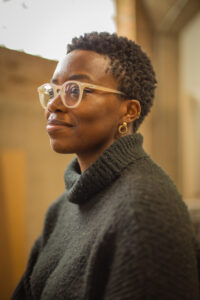Andrea and ebere’s multidisciplinary practices are informed by acts of care and storytelling, that ultimately become actualized within the objects and projects they build out- individually and collectively. Engaging in practices of co-thinking, designing, and building, they both expand on alternative modes for solidarity amongst Black women, restorative design approaches, and a socially informed process of creating.Andrea and ebere will lead us in to a live call and response, directed by their relationships to dreaming, thought processes, and “the work”.
ZOOM REGISTRATION: https://us06web.zoom.us/meeting/register/tZUqcuirqTooE9VNHGJRbDjKaWG2dG5FpvoP

ebere agwuncha (b.1997, Chicago) is a designer, maker, and artist based in Chicago via Anambra State, Nigeria. She earned a bachelor’s degree in Industrial Design from Iowa State University in 2019. Her dexterous practice aims to hybridize various craft and materials including wood, ceramic, and natural fiber. Through creating functional ‘care filled object(s)’ and speculative installations, they aim to preserve Igbo stories through more expansive iterations using a diverse set of techniques. She pushes the cusp of perfection – or imperfection – while intimately using her hands to physicalize ideas. ebere will be an inaugural artist-in-exchange with the Sculpture Department at the School of the Art Institute of Chicago, this spring of 2022. Part of this residency period will be used to produce work for their upcoming first solo show at the Comfort Station (Chicago, IL) this May of 2022.
https://ebereagwuncha.com/

Andrea Yarbrough is a multi-disciplinary artist, curator and educator based on the South Side of Chicago nurturing sites of care through a blend of urban agriculture, civic engagement, and art praxis. Her praxis is embodied through the collaborative placekeeping initiative in c/o: Black women (in care of Black women), bringing together writers, curators, farmers, mamas, dancers, organizers, teachers, cultural producers, youth, and visual artists, to collectively exhume the (in)visibility of care for Black women. Andrea’s process transforms quotidian materials, slated for waste streams, into designed and utilitarian objects that serve as community resources, and incorporates the impact of solidarity and circular economies at the material, individual, and
communal scales. By constructing functionally designed objects, cultivating land, archiving and documenting histories of Black women, and curating exhibitions and public programs, her socially-engaged practice exemplifies how communities can reclaim and reconstruct their surroundings while navigating agency and ownership over underutilized space. She seeks to engage in an arts-integrated ecological approach, as a way to not only treat blight in particular neighborhoods, but to support the restoration of the entire city, all while negotiating new spatial imaginaries, expanding our economies of care. Ultimately, she engages in a community-centered visual arts production that works to reshape land-use policy by activating vacant space as sites
that heal individuals and regenerate collective imaginations. Andrea believes that participatory social praxis art is one of many ways to rewrite a history of redlining, divestment, and violence.
https://incareofblackwomen.us/
3831/VOICES is a new program series of conversations and lectures featuring Black artists, scholars, curators, historians, and arts workers that invite our community into their creative practices, research, and conceptual processes, and more! 3831 takes after SSCAC’s exact numerical address in the historic Bronzeville neighborhood. Although we recognize ourselves as an iconic historical site for Black artistic and cultural advancement, we continue to evolve as a contemporary hub for new thought practices, creative practices, and innovative frameworks being developed by a diverse array of amazing folks here in our city, and beyond.
Image courtesy(above): Andrea Yarbrough



